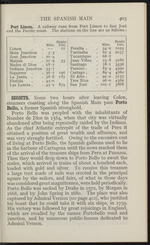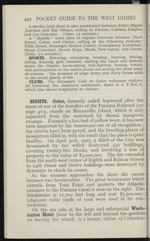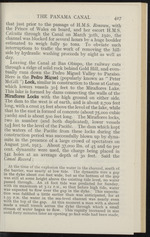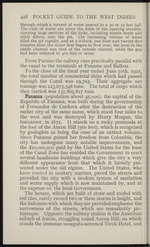| 1 |
 |
“...THE SPANISH MAIN 403
Port Limon. A railway runs from Port Limon to San José
and the Pacific coast. The stations on the line are as follows :
Limon Miles. Height Feet. II Peralta . Miles. • 54*2 Height Feet. 1055
Moin Junction 3-5 Turrialba . 62 5 2037
Zent Junction Matina 20 *4 21 *9 55 Tucumque Juan Vinas . 68-7 • 73*8 3286
Madre di Dios 28-7 Santiago . 78-1 3536
Indiana Junction 35-7 Paraiso . • 85-4 4392
Siquirres 36-7 196 Cartago . . 89-4 4760
La Junta . 38-6 187 El Alto . . 92 *2 5137
Florida 43*o Tres Rios . 96-0 4362
Las Lamas . 45*2 879 San José . 102*1 3868
SIGHTS. Some two hours after leaving Colon,
steamers coasting along the Spanish Main pass Porto
Bello, a former Spanish stronghold.
Porto Bello was peopled with the inhabitants of
Nombre de Dios in 1584, when that city was virtually
abandoned after being repeatedly raided by the Indians.
As the chief Atlantic entrepót of the trade of Peru it
attained a position of great wealth and affluence, and
was very strongly fortified...”
|
|
| 2 |
 |
“...422 POCKET GUIDE TO THE WEST INDIES
A service (2nd class) is also maintained between Pedro Miguel
Junction and Bas Obispo, calling at Paraiso, Culebra, Empire,
and Las Cascadas. (lime, 35 minutes.)
A " shuttle ” train plies at regular intervals between Third
Street, Colon, and Gatun, calling at the following stations :
Fifth Street, Passenger Station (Colon), Commissary (Cristobal),
Shops (Cristobal), Mount Hope, Mindi, New Gatun, and Gatun.
(Time, 25 minutes.)
SPORTS. Motoring, swimming, boating, hunting, fishing,
riding, dancing, golf, baseball, visiting the Canal and historic
spots, the theatre, horse-racing, bull-fighting, boxing, tennis,
and participation in the native fiestas are among the most usual
diversions. The presence of large Army and Navy forces adds
to the social gaiety of life.
CLUBS. The Strangers’ Club at Colon welcomes visitors.
At Cristobal, the American settlement, there is a Y.M.C.A.
which also shows hospitality to visitors.
SIGHTS. Colon, formerly called Aspinwall...”
|
|
| 3 |
 |
“...H.M.S. Renown, with
• the Prince of Wales on board, and her escort H.M.S.
Calcutta through the Canal on March 30th, 1920, the
channel was blocked for several hours by a huge boulder
1 estimated to weigh fully 50 tons. To obviate such
interruptions to traffic the work of removing the hill-
side by hydraulic washing proceeds by night as well as
Leaving the Canal at Bas Obispo, the railway cuts
through a ridge of solid rock behind Gold Hill, and even-
tually runs down the Pedro Miguel Valley to Paraiso.
Here is the Pedro Miguel (popularly known as “ Peter
McGill ”) Lock, similar in construction to those at Gatun
which lowers vessels 30 J feet to the Miraflores Lake!
this lake is formed by dams connecting the walls of the
Miraflores Locks with the high ground on either side.
The dam to the west is of earth, and is about 2,700 feet
long, with a crest 15 feet above the level of the lake, while
that to the east is formed of concrete (about 75,000 cubic
yards) and is about 500 feet long. The Miraflores...”
|
|
| 4 |
 |
“...INDIES
through which a torrent of water poured in a 30 or 35 feet fall.
The rush of water ate away the sides of the opening steadily, j
carrying large sections of the dyke, including trestle bents and
other débris, into the pit. The increasing volume of water
filled the pit rapidly, and at 3 o’clock, one hour and twenty-five
minutes after the water first began to flow over, the level in the
inside channel was that of the outside channel, while the gap
had been widened to 400 feet or more.
From Paraiso the railway runs practically parallel with I
the canal to the terminals at Panama and Balboa.
To the close of the fiscal year ended June 30th, 1925,
the total number of commercial ships which had passed
through the Canal was 29,705. Their aggregate net
tonnage was 123,675,548 tons. The total of cargo which
they carried was 131,869,827 tons.
Panama (population about 45,000), the capital of the
Republic of Panama, was built during the governorship
of Fernandez de Cordova after the destruction of...”
|
|
